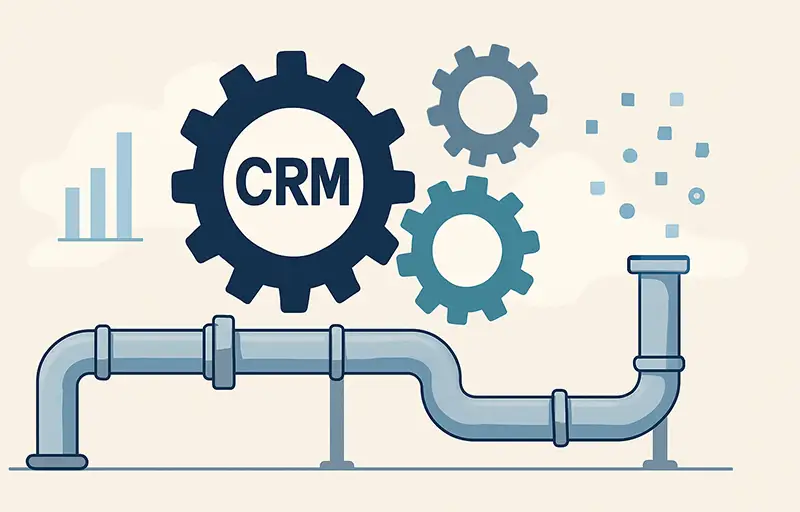What Is a CRM System?
A CRM system (short for Customer Relationship Management system) is software that helps businesses manage their relationships and interactions with prospects and customers.
At its core, a CRM is designed to track every touchpoint across the customer journey. It centralizes data from sales, marketing, and support, giving your team a clear view of what’s happening, what’s been promised, and what to do next.
This isn’t about buying software and hoping it fixes your pipeline. A CRM system is only as good as the sales process it supports. When implemented well, it’s the engine of a structured, scalable B2B sales operation.
“CRM is the key. But only if you commit to using it to drive behaviour, not just record it.” — Fraser Morrison, Founder at 1000Steps
CRM Definition: More Than Just a Contact List
Many still think of a CRM as just a fancy address book. That’s a misperception.
A modern CRM system helps you:
- Track interactions across email, calls, and meetings
- Assign and monitor tasks across sales reps or teams
- Segment leads and customers by stage, value, or fit
- Forecast revenue and spot gaps in your pipeline
- Automate repetitive tasks like follow-ups and lead qualification
It’s not just for salespeople either. Marketing, customer success, and leadership all benefit from visibility into how deals are progressing and where relationships stand.
Why CRM Systems Matter in B2B Sales
In B2B sales, where buying cycles are long and decision-makers are many, structure matters.
Without a CRM:
- Deals fall through the cracks
- Forecasts are based on gut feel
- No one knows who’s following up or what’s been promised
With a CRM:
- You get clarity on the pipeline
- You reduce friction across the team
- You build a repeatable sales process
CRM systems give you the operational backbone to scale relationships, not just record them.
Want to learn how to structure your pipeline? Read more about sales and marketing strategy here.
Key Features of a CRM System
While CRMs vary in complexity, most modern platforms include:
1. Contact Management
Centralized database of leads, customers, and partners. Every interaction is logged in one place.
2. Deal Tracking
Visual pipelines let you track deal stages, assign values, and set close dates. You can see what’s progressing — and what’s stuck.
3. Task & Activity Management
Set reminders, assign tasks, and track outreach. Ideal for managing follow-ups without letting anything slip.
4. Email Integration
CRMs often sync with Gmail or Outlook, auto-logging emails and allowing you to send directly from the platform.
5. Reporting & Forecasting
Real-time dashboards help leaders assess performance, conversion rates, and revenue forecasts.
6. Automation Tools
Automate lead routing, email sequences, and reminders. Save hours every week and ensure consistency.
Common CRM Misconceptions
Despite their value, CRMs often get a bad reputation — usually for the wrong reasons.
“It’s just admin.”
Not if it’s structured well. The right CRM setup reduces admin and makes performance visible.
“It’s too expensive.”
Not having visibility into your pipeline is far more expensive. You can start small and scale.
“Nobody uses it.”
That’s a process problem, not a tool problem. CRM adoption increases when it’s built around how your team actually sells.
CRM is not a magic bullet. But without one, you’re running blind.
If you’re unsure where to start, check out our practical guide to CRM solutions.
How to Choose the Right CRM System
Choosing a CRM is not about features, it’s about fit. Consider:
- Your sales process complexity: Are you selling to enterprises or SMEs? One decision-maker or many?
- Your team size: Solo founder or multi-rep team?
- Your tech stack: What tools do you already use?
- Reporting needs: Do you need robust dashboards or just basic tracking?
We often recommend starting with a CRM that aligns with your current maturity and can grow with you. Tools like HubSpot, Pipedrive, and Salesforce all have their place — but implementation and usage are where the real work begins.
Learn more about how 1000Steps helps with CRM implementation and adoption.
CRM as a Sales Operating System
At 1000Steps, we treat CRM not just as a tool but as a sales operating system. It should:
- Reflect your sales stages and deal types
- Prompt the right behaviours at the right time
- Give sales leaders clarity without chasing reps
- Support coaching, hiring, and scaling
When CRM becomes the hub for how your team thinks, sells, and reflects, it stops being a chore and starts being an advantage.

Get Support Structuring Your CRM
Whether you’re starting from scratch or trying to fix a bloated setup, we can help. 1000Steps offers hands-on support with:
- CRM selection and setup
- Pipeline structuring and deal flow
- Customised dashboards and reporting
- Training and adoption programs
FAQ about CRM Systems
What does CRM stand for?
CRM stands for Customer Relationship Management, a system used to manage and analyze customer interactions and data throughout the lifecycle.
What does a CRM system do?
A CRM system tracks relationships, activities, deals, and communications with leads and customers, helping teams stay organised and proactive.
Is a CRM just for sales teams?
No, while it’s often used in sales, marketing and customer support teams also benefit from shared data, automation, and visibility into customer interactions.
How do I know if my business needs a CRM?
If you’re struggling to track leads, follow up consistently, or forecast revenue, a CRM will provide the clarity and structure you need.
For more foundational terms like CRM system, sales pipeline, and deal stages, check out our B2B Sales Glossary.